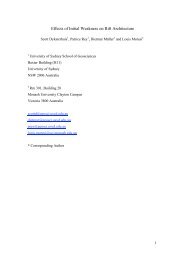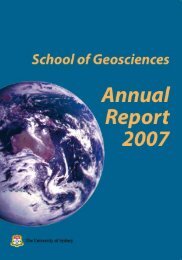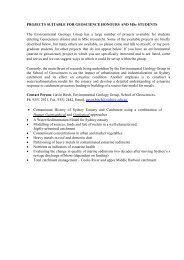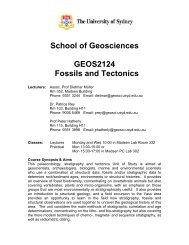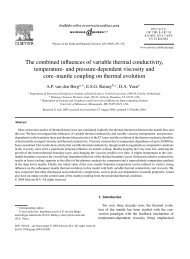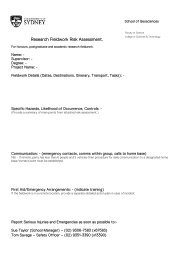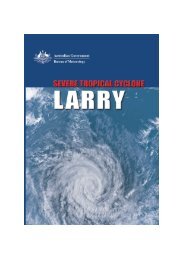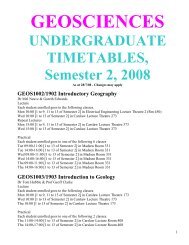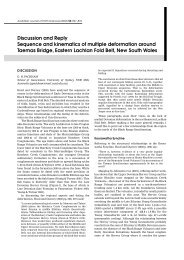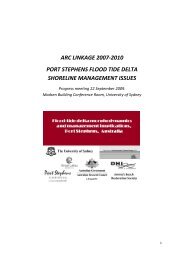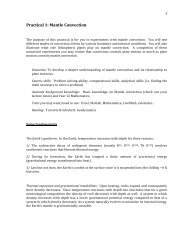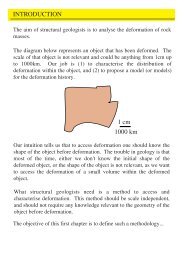Geological and historical records of tsunami in Australia
Geological and historical records of tsunami in Australia
Geological and historical records of tsunami in Australia
Create successful ePaper yourself
Turn your PDF publications into a flip-book with our unique Google optimized e-Paper software.
100 D. Dom<strong>in</strong>ey-Howes / Mar<strong>in</strong>e Geology 239 (2007) 99–123<br />
(Geist et al., 2006). This is important because it can be<br />
seen from Fig. 1a that <strong>Australia</strong> is surrounded by crustal<br />
plate boundaries at which active crustal subduction, high<br />
seismicity <strong>and</strong> volcanic activity are all occurr<strong>in</strong>g. In<br />
<strong>Australia</strong>, little work has been undertaken to catalogue<br />
<strong>tsunami</strong> (a first step towards a proper underst<strong>and</strong><strong>in</strong>g <strong>of</strong><br />
hazard) through an analysis <strong>of</strong> its geological <strong>and</strong><br />
<strong>historical</strong> record. Consequently, the aims <strong>of</strong> this paper<br />
are to:<br />
1. present a prelim<strong>in</strong>ary catalogue <strong>of</strong> <strong>tsunami</strong> reported to<br />
have affected the cont<strong>in</strong>ental ma<strong>in</strong>l<strong>and</strong> <strong>of</strong> <strong>Australia</strong>;<br />
2. provide a summary <strong>of</strong> the geological <strong>and</strong> geomorphological<br />
record <strong>and</strong> characteristics <strong>of</strong> <strong>tsunami</strong> <strong>in</strong><br />
<strong>Australia</strong>; <strong>and</strong> to<br />
3. outl<strong>in</strong>e a series <strong>of</strong> key research questions to help<br />
def<strong>in</strong>e future research priorities with<strong>in</strong> <strong>Australia</strong>.<br />
To achieve these aims, first, a description <strong>of</strong> how the<br />
catalogue was constructed is provided. The attributes <strong>of</strong><br />
each <strong>tsunami</strong> are outl<strong>in</strong>ed <strong>and</strong> a ‘validity score’ <strong>and</strong><br />
‘<strong>tsunami</strong> <strong>in</strong>tensity score’ are given to each event. Second,<br />
a discussion <strong>of</strong> selected <strong>tsunami</strong> <strong>and</strong> their geological<br />
<strong>records</strong> <strong>and</strong> effects are provided <strong>in</strong> order to characterise<br />
<strong>and</strong> compare these <strong>records</strong> (signatures) with <strong>tsunami</strong><br />
elsewhere <strong>and</strong> to explore how the geological record may<br />
help to improve our underst<strong>and</strong><strong>in</strong>g <strong>of</strong> <strong>tsunami</strong> <strong>in</strong> <strong>Australia</strong>.<br />
Lastly, the significance <strong>of</strong> the <strong>Australia</strong>n <strong>tsunami</strong><br />
record is discussed <strong>and</strong> issues identified that might direct<br />
future research priorities <strong>in</strong> the region. Whilst this work<br />
cannot be considered complete, the purpose <strong>of</strong> present<strong>in</strong>g<br />
it at this stage is to stimulate further scientific research<br />
to ref<strong>in</strong>e <strong>and</strong> improve our underst<strong>and</strong><strong>in</strong>g <strong>of</strong><br />
<strong>tsunami</strong> <strong>in</strong> <strong>Australia</strong> <strong>and</strong> to enrich the emerg<strong>in</strong>g ATWS<br />
with data.<br />
2. Construction <strong>of</strong> the catalogue<br />
Information about <strong>tsunami</strong> that have impacted<br />
<strong>Australia</strong> is already available. However, much <strong>of</strong> this<br />
<strong>in</strong>formation is fragmentary, variable <strong>in</strong> quality <strong>and</strong><br />
extent, is spread between (<strong>and</strong> with<strong>in</strong>) numerous datasets<br />
— some unpublished <strong>and</strong> is known to only a few. Here,<br />
an attempt is made to draw together different <strong>in</strong>formation<br />
sets on <strong>tsunami</strong> reported for <strong>Australia</strong> for the benefit <strong>of</strong><br />
the wider scientific <strong>and</strong> disaster management communities.<br />
The pr<strong>in</strong>ciple data sets used are the Geoscience<br />
<strong>Australia</strong> — <strong>Australia</strong>n Tsunami Database (unpublished),<br />
NOAA/NGDC Tsunami Event Database, Rynn<br />
(1994), the Sydney Morn<strong>in</strong>g Herald (1858–present),<br />
<strong>Australia</strong>n regional newspapers (various dates), various<br />
unpublished government reports <strong>and</strong> additional unpublished<br />
data held with<strong>in</strong> the Risk Frontiers Compactus at<br />
Macquarie University, Sydney. The catalogue <strong>in</strong>cludes<br />
<strong>tsunami</strong> that affected the ma<strong>in</strong>l<strong>and</strong> cont<strong>in</strong>ental coastl<strong>in</strong>e,<br />
the state <strong>of</strong> Tasmania <strong>and</strong> Lord Howe <strong>and</strong> Norfolk<br />
Isl<strong>and</strong>s only (Fig. 1b). It does not <strong>in</strong>clude the <strong>Australia</strong>n<br />
Antarctic territories, the <strong>Australia</strong>n dependencies <strong>and</strong><br />
former <strong>Australia</strong>n territorial l<strong>and</strong>s. Tsunami that affected<br />
these later regions are excluded from this study because:<br />
Antarctica requires special consideration <strong>and</strong> a unique<br />
approach to determ<strong>in</strong><strong>in</strong>g its <strong>tsunami</strong> history; territorial<br />
dependencies may more readily, conveniently <strong>and</strong><br />
sensibly be treated as part <strong>of</strong> other geographic areas<br />
(e.g., Micronesia) or because specific locations are now<br />
their own autonomous federal states <strong>and</strong> as such, deserve<br />
their own catalogues (e.g., Papua New Gu<strong>in</strong>ea).<br />
For each event, the catalogue supplies: the correspond<strong>in</strong>g<br />
ID (event) number, the date <strong>of</strong> occurrence<br />
(year, month <strong>and</strong> day), the source region <strong>of</strong> the <strong>tsunami</strong>,<br />
the <strong>tsunami</strong>genic cause, the region <strong>of</strong> impact <strong>in</strong> <strong>Australia</strong>,<br />
the maximum (max (H)) wave height <strong>and</strong>/or<br />
distance <strong>of</strong> <strong>in</strong>undation data, a comment description, an<br />
<strong>in</strong>dication <strong>of</strong> the <strong>tsunami</strong> <strong>in</strong>tensity (TI) <strong>of</strong> each event<br />
based upon the 12 po<strong>in</strong>t (I–XII) <strong>tsunami</strong> <strong>in</strong>tensity scale<br />
<strong>of</strong> Papadopoulos <strong>and</strong> Imamura (2001) (TI: I=not felt,<br />
II=scarcely felt, III=weak, IV=largely observed,<br />
V=strong, VI= slightly damag<strong>in</strong>g, VII=damag<strong>in</strong>g,<br />
VIII =heavily damag<strong>in</strong>g, IX=destructive, X=very destructive,<br />
XI =devastat<strong>in</strong>g <strong>and</strong>, XII =completely devastat<strong>in</strong>g)<br />
<strong>and</strong> an <strong>in</strong>dication <strong>of</strong> the validity <strong>of</strong> the <strong>tsunami</strong><br />
event (based upon the NOAA/NGDC Tsunami Event<br />
Database classification: 0 = erroneously listed event,<br />
1=very doubtful <strong>tsunami</strong>, 2=questionable <strong>tsunami</strong>,<br />
3=probable <strong>tsunami</strong>, 4=def<strong>in</strong>ite <strong>tsunami</strong>). Lastly, the<br />
orig<strong>in</strong>al sources for each event are listed. This format<br />
follows the NOAA National Geophysical Data Center<br />
“Tsunami Event Database” catalogue (see: http://www.<br />
ngdc.noaa.gov/seg/hazard/tsevsrch_idb.shtml for further<br />
details). This is the first time that such a detailed <strong>and</strong><br />
publicly available, <strong>tsunami</strong> catalogue for <strong>Australia</strong> has<br />
been collated. Of particular importance, the present<br />
author applies a ‘validity score’ to each event based<br />
upon an evaluation <strong>of</strong> the evidence (published or<br />
otherwise) used to identify the <strong>tsunami</strong> by the orig<strong>in</strong>al<br />
report<strong>in</strong>g author/organisation. Some events have been<br />
listed with a ‘validity score’ <strong>of</strong> zero (0) mean<strong>in</strong>g that an<br />
event has been erroneously listed. I choose to reta<strong>in</strong><br />
these events with<strong>in</strong> the catalogue to show readers that a<br />
careful cross-check <strong>of</strong> the orig<strong>in</strong>al sources for these<br />
events has been completed. This will allow readers to be<br />
confident that I have considered such events rather than<br />
over-look<strong>in</strong>g any that may have been listed elsewhere.<br />
Also, for the first time for <strong>Australia</strong>n <strong>tsunami</strong>, a <strong>tsunami</strong>



